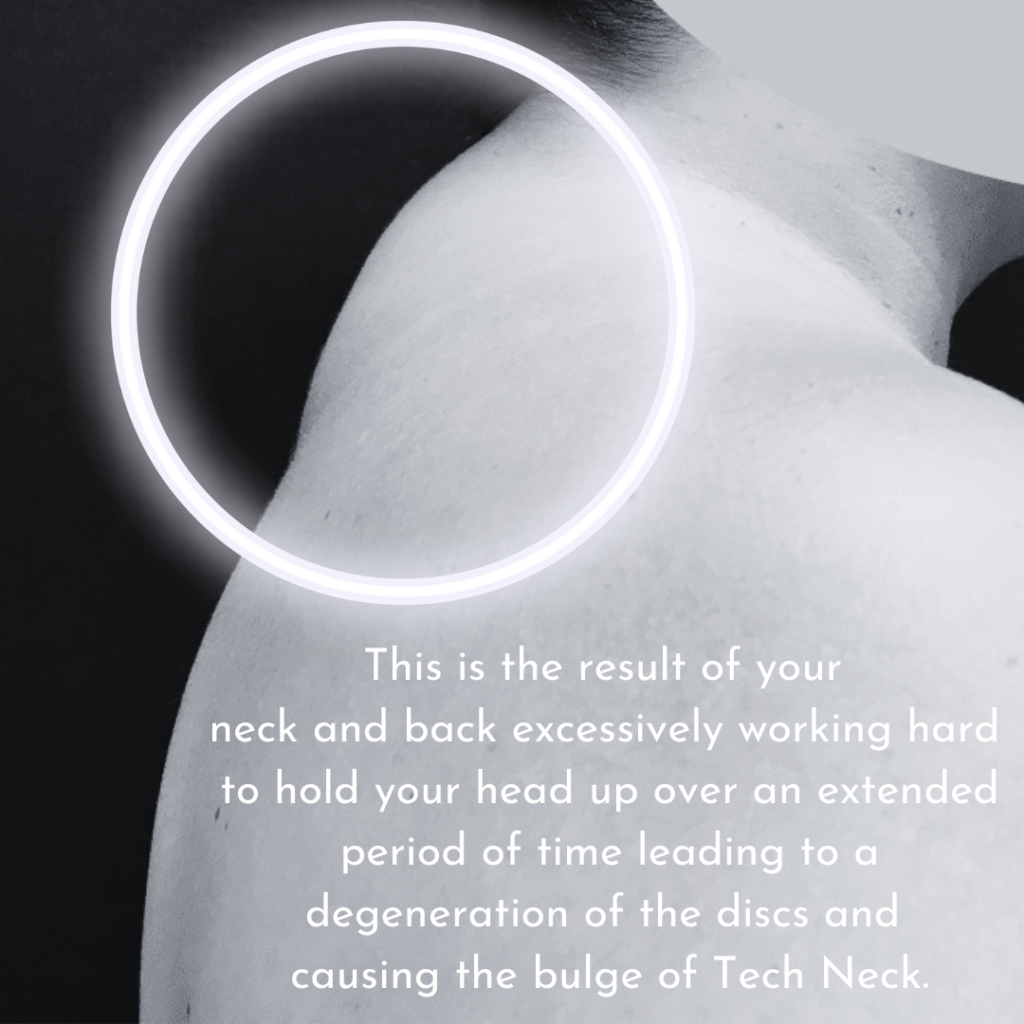Do you know what Tech Neck is (aka Text Neck)? Are you aware of the different side effects that can result from Tech Neck?
In this blog, we’ll discuss: when Tech Neck occurs, how your posture plays a role, how the weight of your head increases with forward position, and how to prevent Tech Neck.
Cervical Kyphosis, better known as Tech Neck and Text Neck, is an increasingly problematic issue. Cervical Kyphosis happens when the top of the spine curves in the opposite direction than normal, which can lead to neck and upper back tension, or other potential health problems.
When Can Tech Neck Occur?
- Tech Neck side effects can result from:
- using smartphones, computers, and tablets with improper head and neck support.
- putting your neck in an over-stressed forward curve for too long or too often.
- placing too much stress on your upper spine, causing trapezius and upper back pain.
According to published research, there is an association between extended mobile phone use and neck pain. This is especially a problem for children and adolescents, who spend much of their free time using mobile devices. Research shows that young Americans who spend around four hours daily on electronic gadgets could increase the risk of Tech Neck. Tech Neck can have negative effects on your health and the Cervical Spine, which can become severe, and eventually require surgery.
What Do You Know About Your Neck?
Your neck, also named the cervical spine, is the most mobile and flexible part of the human body! It is made up of seven small vertebrae and allows the head to move up-and-down and side-to-side. Your neck helps to smooth out the backward, or kyphotic curve, of the thoracic spine to equally distribute the weight of your head.
Because your neck is so flexible, it is often more prone to pain and injury. Trauma is the most common cause of cervical injury, which can include whiplash from motor vehicle accidents, blunt trauma, or sports-related injuries. Nontraumatic causes can include compression fractures from osteoporosis, arthritis, cancer, or inflammation of the spinal cord. Cervical injury can be a result of flexion, extension, rotation, contusion, and compression of the spinal cord.
Why The Weight of The Human Head Can Cause Tech Neck:
The neck normally sustains the normal adult head’s weight of 10-12 pounds. However, when you lean your head forward, gravity increases the tension on the muscles of the neck, and the weight of the head increases to approximately 50-60 pounds of force on these muscles. Your neck is not designed to keep that kind of force over long durations of time. As a result, there can be muscular and ligamentous discomfort, as well as other structural problems that can cause pain.

The Impacts of Tech Neck:
- Tech Neck can make a big impact on your health, so it’s important that you make lifestyle changes to avoid Tech Neck’s side effects. The following symptoms can all be associated with your posture during the use of mobile phones and computers:
- Structural back and neck problems
- Emotional panic and breathing problems
- Shoulder pain
- Headaches
- Inflammation or stiffness in neck muscles and connective tissues
- Long-term degeneration of the cervical spine
- Herniated discs in your cervical spine
- Possible neck sprains, similar to injury from whiplash
- Could develop an irreversible hunch-backed appearance
Tips To Prevent Tech Neck:
- Preventing Tech Neck is possible, however, we need to be aware of how long we use devices, how our bodies are sitting or standing over long periods of time, and try new exercises that can get our bodies moving more frequently. So, below are a few tips to prevent Tech Neck…
- Raise your device to eye level. Bring your phone up to your face. Position your laptop screen higher by setting on a couple of large books.
- Sit back on a chair with a headrest to prevent from flexing your neck forward to look down.
- Take work breaks; get up and move around. Remember to stretch!
- Establish limits for spending time on devices.
- Correct your posture whenever you pass a mirror.
- Perform some aerobic exercise daily, like jogging, swimming or walking.
- Stretch and strengthen your neck, chest, and upper back muscles to prevent long-term forward head posture imbalances.
- Pay attention to the tension when you start to feel it. Lean back, stretch, and do some self-massage on your traps.
- Visit a chiropractor regularly, to remediate the side effects of Tech Neck.
Always be aware of your posture, and reach out if you have any questions. Dr. Bob Bacon is ready to handle your chiropractic corrections, and provide whole food supplements that can support muscular and joint health!
Follow Dr. Bob Bacon on YouTube, Facebook, and Instagram to learn more about holistic healing and nutrition, @DrBobBacon .
Check out our supplement shop for supportive solutions like Ligaplex I and Calcifood. These supplements could help improve joint health in relation to Tech Neck.


